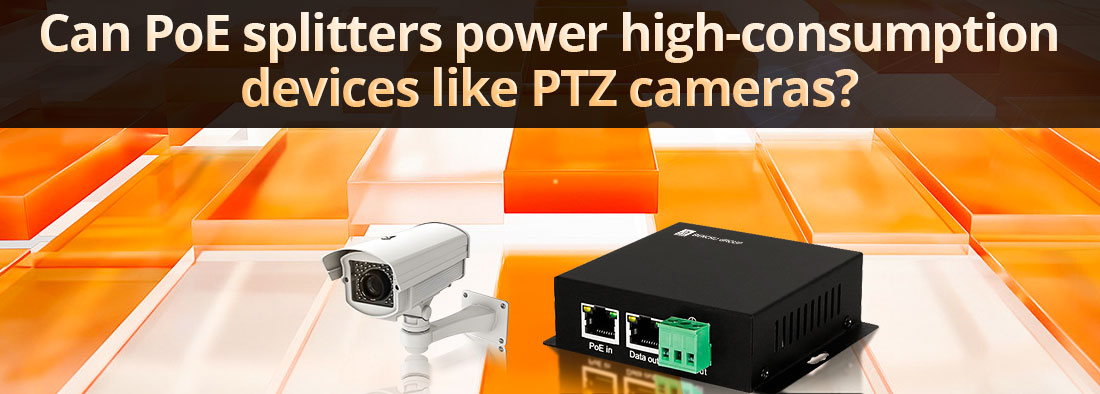
Yes, PoE splitters can power high-consumption devices like PTZ (Pan-Tilt-Zoom) cameras, but selecting the right type of PoE splitter is crucial. PTZ cameras require more power than standard IP cameras due to their motorized movement, zoom functions, and sometimes built-in heating elements for outdoor use. To ensure proper operation, you need a high-power PoE splitter that meets the power requirements of your PTZ camera.
Key Factors to Consider for Powering PTZ Cameras with a PoE Splitter
1. Power Requirements of PTZ Cameras
PTZ cameras generally have higher power consumption than regular IP cameras. Their power needs can range from:
--- Standard PTZ Cameras: ~12W to 15W (for basic models)
--- Advanced PTZ Cameras: 20W to 30W (for models with IR night vision, AI processing, or auto-tracking)
--- Outdoor PTZ Cameras with Heaters: 30W to 60W (requires high-power PoE splitters)
Check the PTZ camera’s power rating before selecting a PoE splitter.
2. PoE Standards and Compatibility
PoE splitters must be compatible with the correct PoE standard to deliver sufficient power. There are three main PoE standards:
--- IEEE 802.3af (PoE): Up to 15.4W – Suitable for small IP cameras but insufficient for PTZ cameras.
--- IEEE 802.3at (PoE+): Up to 30W – Works for mid-range PTZ cameras but may not support models with heaters or IR illuminators.
--- IEEE 802.3bt (PoE++) Type 3/4: Up to 60W-100W – Required for high-power PTZ cameras, outdoor models with heaters, and multi-sensor security cameras.
For PTZ cameras, choose at least a PoE+ (802.3at) or PoE++ (802.3bt) splitter.
3. Voltage Output & Device Compatibility
--- Most PTZ cameras operate on 12V DC or 24V DC. A PoE splitter should match the exact voltage requirement of the camera to ensure safe and efficient operation.
Look for a PoE splitter with adjustable voltage output (12V/24V) to match your PTZ camera’s needs.
4. High-Efficiency Power Conversion
--- High-power PoE splitters should have at least 85-90% power conversion efficiency to minimize energy loss and prevent overheating. Efficient power conversion is essential for delivering stable power to a PTZ camera, which may experience fluctuating power demands due to motor movements and IR activation.
Choose a splitter with a high-efficiency DC-DC power conversion chipset.
5. Gigabit Data Support for Smooth Video Streaming
--- PTZ cameras often transmit high-definition video (1080p, 4K, or AI-enhanced feeds), requiring a high-bandwidth connection. A high-quality PoE splitter should support Gigabit Ethernet (1000 Mbps) to ensure smooth video transmission.
Ensure the PoE splitter supports at least 1Gbps speeds, especially for 4K PTZ cameras.
Best PoE Splitter Types for PTZ Cameras
| PoE Splitter Type | Power Output | Suitable for |
| Standard PoE Splitter (802.3af) | 12V, 15W | Basic IP cameras (not PTZ) |
| PoE+ Splitter (802.3at) | 12V/24V, 25-30W | Mid-range PTZ cameras |
| PoE++ Splitter (802.3bt Type 3) | 12V/24V, 60W | High-power PTZ cameras with heaters/IR |
| Ultra PoE Splitter (802.3bt Type 4) | 12V/24V, 90-100W | Industrial-grade PTZ cameras, multi-sensor setups |
For most PTZ cameras, a PoE++ (802.3bt) splitter with at least 30W to 60W power output is ideal.
Alternative Solutions for Powering High-Consumption PTZ Cameras
1. PoE Injectors (Instead of PoE Splitters)
If your network switch does not support PoE++ (802.3bt), you can use a PoE injector instead of a splitter.
--- Pros: Directly injects the correct power level into the Ethernet cable, eliminating extra wiring.
--- Cons: Requires an additional device and a nearby power source.
2. High-Power PoE Switches
Instead of using a PoE splitter, consider upgrading to a PoE++ (802.3bt) switch that can provide up to 90W per port.
--- Pros: Centralized power management, eliminates extra splitters.
--- Cons: Higher cost than using a splitter.
Conclusion: Can a PoE Splitter Power a PTZ Camera?
Yes, but it depends on the power requirements of the PTZ camera and the capabilities of the PoE splitter.
--- For PTZ cameras consuming 15W-30W → Use a PoE+ (802.3at) splitter (supports up to 30W).
--- For PTZ cameras requiring 30W-60W → Use a PoE++ (802.3bt Type 3) splitter (supports up to 60W).
--- For high-power PTZ cameras (60W-100W) → Use a PoE++ (802.3bt Type 4) splitter or consider a PoE++ switch.